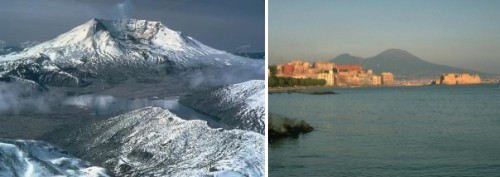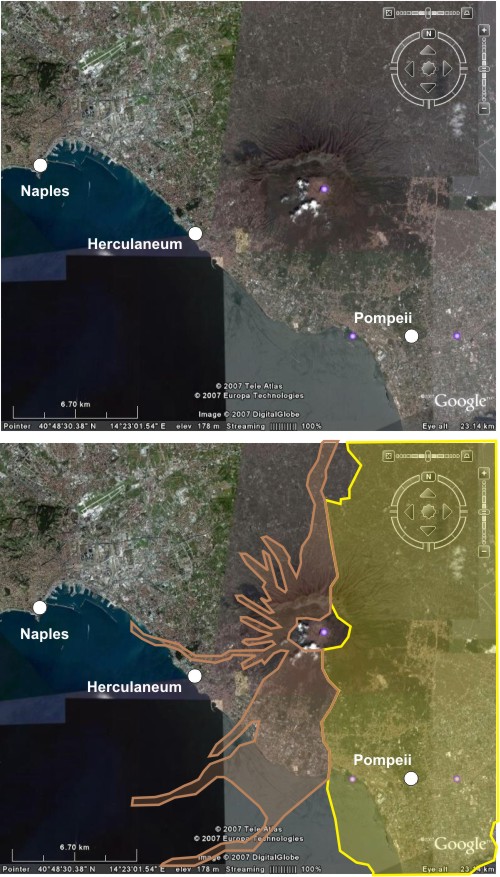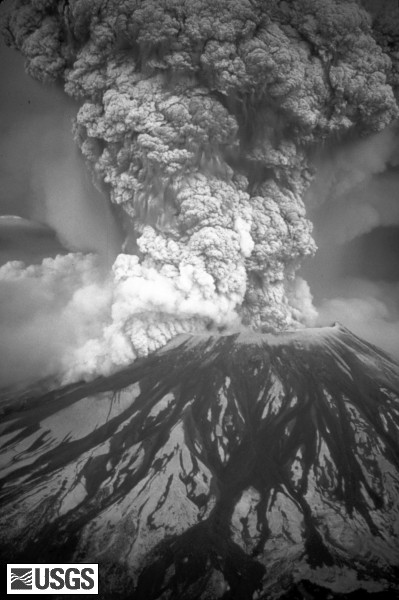The theme for the second edition of The Accretionary Wedge is “Total Destruction”. Anyone who has studied geology knows that there is no shortage of things on, within, and even outside the Earth that are capable of making things decidedly unpleasant for human civilisation. Some of us have even become professional doom-mongers, never passing up an opportunity to explain in gory detail how we’re all going to be wiped out by an asteroid strike, or a megatsunami, or a supervolcanic eruption. Unfortunately, constantly proclaiming “The End is Nigh (give or take 10,000 years or so)!” encourages a certain fatalism, ignoring the fact that for many of the geological hazards most likely to affect us, it is possible to for us to take steps to minimise the risks; the problem is that we’re just not very good at it. To illustrate this point, I’m going to use two of the more famous volcanoes in the world: Mount St. Helens, and Vesuvius

Both of these volcanoes are prone to quite explosive volcanic eruptions because the magma which supplies them is rich in dissolved water, and gases like carbon dioxide. As soon as the pressure which is holding these gases in solution is released, either by rapid ascent of magma to the surface or by the rupturing of the chamber that confines it, the effect is akin to opening a vigorously shaken fizzy drink bottle. The eruption of Mt St Helens in May 1980 was a dramatic demonstration of this effect: an earthquake-triggered landslide on the north face of the mountain released enough pressure on the magma chamber to trigger a massive eruption which blew more than a cubic kilometre of material up into the atmosphere:
Ash fell over a sizeable chunk of the north-western US, but the area around Mt St Helens itself was punished much more severely: hot gases, ash, and pumice blasted out as well as up at near-supersonic speeds, flattening every tree in a 13 kilometre radius. Further, pyroclastic flows, and lahars (volcanic mudflows), added to the damage. You can get an idea of the extent of the damage from the satellite images below (source); in the lower version, I’ve highlighted the extent of the original pyroclastic shock-wave (yellow) and the lahars (brown), with the help of this map.

Vesuvius’ most famous eruption is a bit more remote in time – 79 AD to be precise – but we still have the benefit of an eyewitness account
The cloud was rising from a mountain-at such a distance we couldn’t tell which, but afterwards learned that it was Vesuvius. I can best describe its shape by likening it to a pine tree. It rose into the sky on a very long “trunk” from which spread some “branches.” I imagine it had been raised by a sudden blast, which then weakened, leaving the cloud unsupported so that its own weight caused it to spread sideways. Some of the cloud was white, in other parts there were dark patches of dirt and ash.
If you read that whilst looking at the image of the Mount St Helens eruption, there’s a certain resemblance, I think. The Global Volcanism Program database assigns both eruptions a 5 on the Volcanic Explosivity Index, which means that they were of roughly comparable size. The destructive forces at work were also similar: Pompeii was engulfed by ash and pyroclastic flows, whilst Herculaneum was buried by a lahar. What’s quite spooky is that if you rotate the damage pattern for the Mount St Helens eruption by 90 degrees, and overlay it on an image of Vesuvius, it marches up remarkably well with the fates of those two ancient settlements.

However, it becomes even more disturbing for modern day Naples if you flip the damage pattern 90 degrees the other way:

This brings me – in a rather long-winded way – to my point. As spectacular and locally destructive as the Mount St Helens eruption was, it was limited in both its global effects – it was an order of magnitude smaller than the 1991 Mount Pinatubo eruption – and in its human cost; the area around the volcano was fortunately sparsely populated, so the blast only claimed the lives of 57 people. The lesson is that these eruptions only present a significant risk to human life if you’re foolish enough to settle en masse in their shadow. Which is exactly the situation in Naples. After a few centuries of fairly regular activity, since 1944, Vesuvius has fallen silent. This doesn’t necessarily mean that a large eruption is in the works, but if it did erupt like Mount St Helens – and history tells us that it is certainly capable of doing so – there are almost three million people living within the potential blast radius. Even though there is likely to be some warning of a large eruption (such as earthquakes and swelling of the volcano flanks), trying to evacuate that many people in a matter of mere days or weeks is not going to be easy.
In truth, if you are looking to save as many lives as possible, then getting those 3 million people to live in a place where they don’t face the risk of being erupted upon in the first place would be the safest course. On the face of it, suggesting that maybe we should abandon Naples seems absurd, and you are no doubt laughing at me for doing so. But I think we need to start facing up to the fact that whilst we now have the scientific knowledge to assess long-term risks, we are still utterly useless at factoring them into our decisions. The plain fact of the matter is that in our ignorance, we have built a number of cities on top of proverbial geological minefields: and as Hurricane Katrina tried to show New Orleans, there are only so many times we can dodge the bullets when Mother Nature has thousands of years to shoot them at us.
Categories: geohazards, volcanoes




Comments (11)